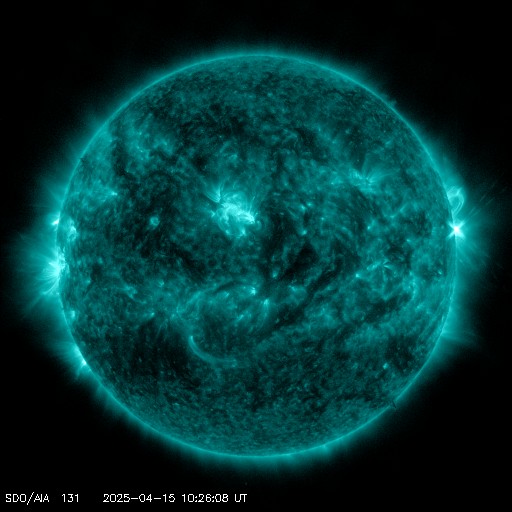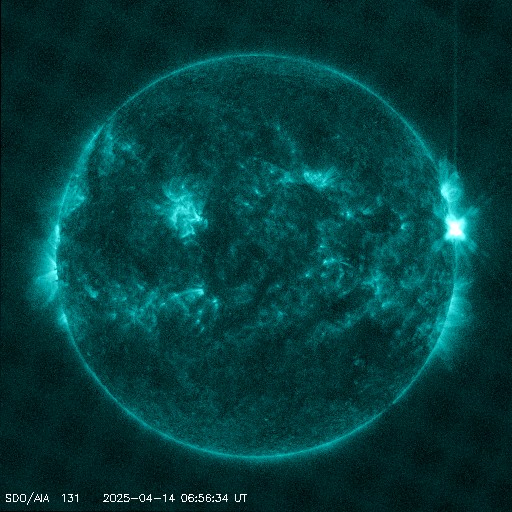Viewing archive of Tuesday, 25 September 2001
Solar activity report
Any mentioned solar flare in this report has a scaling factor applied by the Space Weather Prediction Center (SWPC). Because of the SWPC scaling factor, solar flares are reported as 42% smaller than for the science quality data. The scaling factor has been removed from our archived solar flare data to reflect the true physical units.
Report of Solar-Geophysical Activity 2001 Sep 25 2200 UTCPrepared by the NOAA © SWPC and processed by SpaceWeatherLive.com
Joint USAF/NOAA Report of Solar and Geophysical Activity
SDF Number 268 Issued at 2200Z on 25 Sep 2001IA. Analysis of Solar Active Regions and Activity from 24-2100Z to 25-2100Z
Solar activity was high. Region 9628 (S18W14) produced
an M7/1n with associated Type II sweep at 0440 UTC. In addition, the
region also generated an M2/1n with Type II at 1027 UTC, and an
M1/Sf at 0148 UTC. This region was the premier flare site of the day
as Region 9632 (S19E06), the site of the X2/2b flare of 24/1038 UTC,
was unproductive. There are fifteen spotted regions visible today,
with new region 9638 (N03E61), the most recent addition.
IB. Solar Activity Forecast
Solar activity is expected to be
moderate to high. Both Regions 9628 and 9632 retain the potential
for additional M-class activity, and a possible isolated X-class
event.
IIA. Geophysical Activity Summary 24-2100Z to 25-2100Z
The geomagnetic field was quiet until the end of the interval. A
shock, presumably related to the flare/CME of 24/1038 UTC, passed
ACE at approximately 2003 UTC. A sudden impulse then occurred at
Boulder at 2025 UTC, measuring 25 nT. The field is now at active
levels. The proton events at greater than 10 and 100 MeV continue.
The tentative peak flux for the greater than 10 MeV event is 5040
pfu at 2100 UTC. The greater than 100 MeV tentative max was 31 pfu
at 0755 UTC. The Polar Cap Absorption event remains in progress.
IIB. Geophysical Activity Forecast
The geomagnetic field is
expected to be at major storm levels during the next 24-36 hours,
due to the effects of a shock/cme related to the X2/2b flare of
24/1038 UTC. The storm should persist through 27 September. The
current proton events are expected to continue for at least the next
24 hours.
III. Event Probabilities 26 Sep to 28 Sep
| Class M | 80% | 80% | 80% |
| Class X | 30% | 30% | 30% |
| Proton | 99% | 90% | 75% |
| PCAF | in progress | ||
IV. Penticton 10.7 cm Flux
Observed 25 Sep 275 Predicted 26 Sep-28 Sep 270/265/260 90 Day Mean 25 Sep 169
V. Geomagnetic A Indices
Observed Afr/Ap 24 Sep 005/006 Estimated Afr/Ap 25 Sep 010/012 Predicted Afr/Ap 26 Sep-28 Sep 080/100-040/040-015/015
VI. Geomagnetic Activity Probabilities 26 Sep to 28 Sep
| A. Middle Latitudes | |||
|---|---|---|---|
| Active | 05% | 10% | 20% |
| Minor storm | 25% | 50% | 60% |
| Major-severe storm | 65% | 25% | 15% |
| B. High Latitudes | |||
|---|---|---|---|
| Active | 05% | 10% | 15% |
| Minor storm | 25% | 40% | 60% |
| Major-severe storm | 70% | 40% | 20% |
All times in UTC
Current data suggests there is a slight possibility for aurora to appear at the following high latitude regions in the near future
Fairbanks, AKLatest news
Latest forum messages
Incoming & Unnumbered Active Regions 1709Potential AR4062 10Ask your obscure/"stupid" space weather questions. 3552025/04/12-13 Filament CMEs 2025/04/16 G2 Watch 56Filaments and prominences 62
More topicsSupport SpaceWeatherLive.com!
A lot of people come to SpaceWeatherLive to follow the Sun's activity or if there is aurora to be seen, but with more traffic comes higher server costs. Consider a donation if you enjoy SpaceWeatherLive so we can keep the website online!

Latest alerts
10:39 UTC - Solar flare
Moderate M1.52 flare from sunspot region 4055
10:24 UTC - Radio Blackout
Minor R1 radio blackout in progress (≥M1 - current: M1.52)
Monday, 14 April 2025
23:15 UTC - Geomagnetic activity
Active geomagnetic conditions (Kp4) Threshold Reached: 23:01 UTC
07:09 UTC - Solar flare
Moderate M4.28 flare from sunspot region 4055
06:48 UTC - Radio Blackout
Minor R1 radio blackout in progress (≥M1 - current: M1.53)
Space weather facts
| Last X-flare | 2025/03/28 | X1.1 |
| Last M-flare | 2025/04/14 | M4.2 |
| Last geomagnetic storm | 2025/04/06 | Kp5 (G1) |
| Spotless days | |
|---|---|
| Last spotless day | 2022/06/08 |
| Monthly mean Sunspot Number | |
|---|---|
| March 2025 | 134.2 -20.4 |
| April 2025 | 128.8 -5.4 |
| Last 30 days | 129.1 -15.1 |





